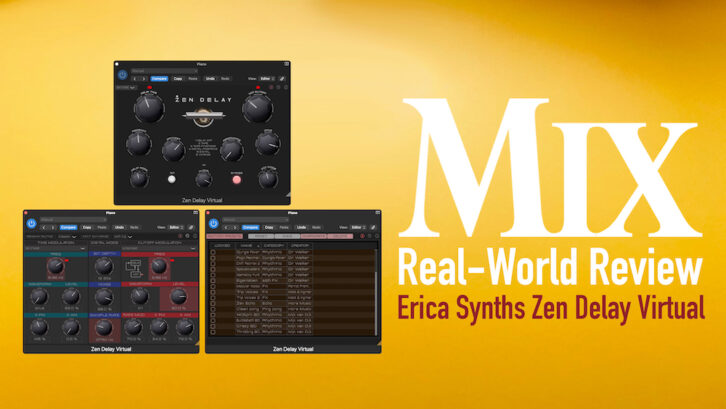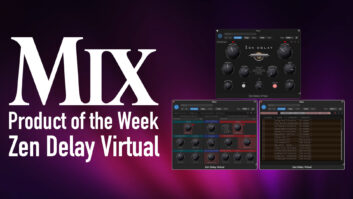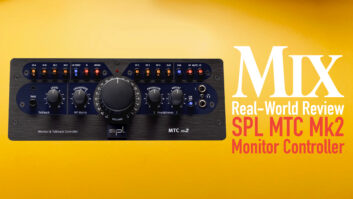
| MIX VERDICT: ERICA SYNTHS ZEN DELAY VIRTUAL PLUG-IN |
| THE TAKEAWAY: “There’s no shortage of delay plug-ins, but it’s rare to find one as creatively inspiring as Zen Delay Virtual.” |
| COMPANY: Erica Synths • www.ericasynths.lv PRICE: $99 PROS: • Four delay algorithms. • LFO and modulation sections add rhythmic possibilities. • Excellent factory presets. CONS: • Doesn’t support AAX format for Pro Tools. |
There’s no shortage of delay plug-ins. Most sound fine and do what they’re supposed to, but it’s rare to find one as creatively inspiring as Zen Delay Virtual by the Latvian manufacturer Erica Synths.
The plug-in is a software emulation of a hardware signal processor called the Ninja Tune Zen Delay that Erica Synths created in collaboration with an electronic music label, Liquid Sky Artist Collective/Air Liquide.
ZDV, which comes as a plug-in and a standalone application, contains a delay with a filter, a modulation section, and an authentic-sounding tube-drive emulation. It’s capable of everything from simple delays to other-worldly effects that alter time, pitch and frequency composition. It’s more like a multi-effects processor than a simple delay. Though designed with electronic music in mind, it’s also useful when working in other genres and for sound design.
The left side of the main screen (aka, “Main Controls”) features standard delay controls, including Delay Time (up to 5000 ms), Feedback, Dry/Wet, Tap Tempo and Delay Mode. The Delay Mode is a six-way switch for selecting one of five algorithms: Tape, Tape Pingpong, Digital, Digital Pingpong and Vintage. The first position of the Delay Mode switch turns the delay off but doesn’t affect the Filter, Drive and Modulation processes.
A significant difference between the Digital and Tape algorithms is that changing the delay time on the latter causes audible pitch changes.
The knobs and switches for the Filter stage are also in the Main Controls. They include VCF Cutoff, Resonance and VCF Mode. The latter lets you set the filter to low-pass, band-pass or high-pass operation. The delay and filter effects can be synched to the host tempo in the plug-in version. If you’re using the standalone application, you can sync it to incoming MIDI clock. A tap tempo button is also included.
Another button near the top right switches the view to the Modulation & Options page. Here, you can modulate the delay time and the bit depth when you’re in one of the digital modes. It’s also possible to route the filter stage so that it’s in the feedback loop.
DPA 2012 and 2015 Cardioid Mics – A Mix Real-World Review
The factory presets, available on the separate Preset Manager page, do an excellent job of showing off ZDV’s prodigious capabilities. Quite a few of them are pretty extreme. If you want to save one of your own settings, you can do so to a separate user bank.
One significant limitation of the plug-in is that ZDV is only available in VST2, VST3 and AU formats, with no AAX component. You’ll need a wrapper to run it in Pro Tools. Presumably, Pro Tools support isn’t as crucial in the European market, but it would be useful here in the States.
Other than that, I have nothing but praise for Zen Delay Virtual. It’s a well-made and powerful plug-in, and I thoroughly enjoyed experimenting with it. It was perfect for adding excitement and complexity to synth patches, drum and percussion loops, samples and more.
It was also great when applied subtly, such as adding lightly modulated delays to guitar or vocal tracks.
If you enjoy getting creative with sound—either live or in the studio—you’re going to love Zen Delay Virtual.







